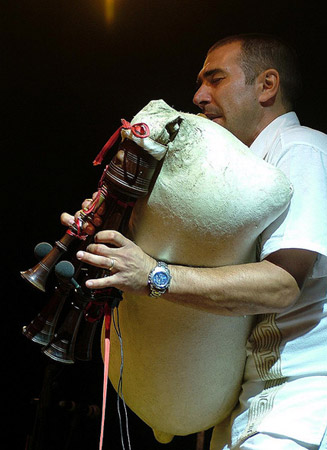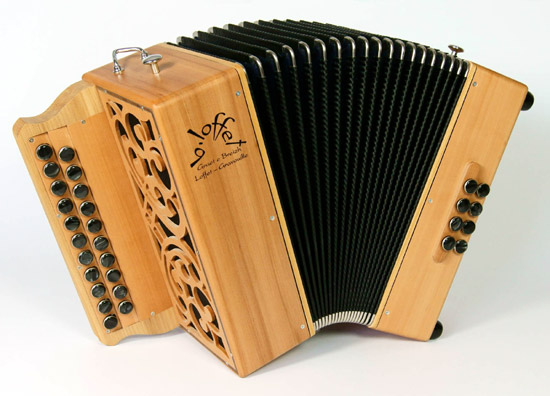Music: Instruments and Ensembles
Aerophones
Wind Instruments
Many aerophones are used in Italian music, including well-known instruments such as the clarinet, which was used in Italy as early as the 18th century. A variety of folk wind instruments have also been used throughout the years.
The firlinfeu is a panpipe popular in the Brianzia region of Italy; it features a curved array of pipes with largest (lowest tones) at the left and smallest (highest tones) at the right. It usually features around 24 pipes. The friscalettu is a Sicilian fipple flute made out of cane. It features seven finger holes and two thum holes, and is still used as a traditional instrument. Other Italian folk flutes include the solitu, a traditional Sardinian shepherd’s flute.
One of the most distinct traditional Italian wind instruments is the quartara, which is a ceramic pitcher found in Sicily and Campania. Blowing across an opening in the narrow neck of the quartara produces a flute tone.
Bagpipes
The zampogna is a family of double-chantered bagpipes that were traditionally played by Italian peasants primarily throughout Southern and Central Italy. The two chanters of the zampogna are fingered separately, and the instrument can have between one and four drones. Each of these pipes is anchored to a single round piece of wood from which the bag—generally made of goatskin—protrudes. There are various forms of the zampogna—some of which are double-reeded and others of which are single-reeded—played in different regions; a musician who plays the zampogna is known as a zampognaro.
The tradition nearly died during the Fascist period: a (possibly apocryphal) story relates that Mussolini compelled the nation’s zampognari to attend a gathering in which they were to give a grand performance; those who were too old or ill to travel avoided execution in this purge, and it is from them that the remnants of the repertoire survived. In the aftermath of the war, the instrument became known largely for its role in Christmas music, but in recent years a revival has widened its repertoire once again.
Accordions
The ddu botte is a traditional Abruzzese accordion. and one of the symbols of Abruzzese culture. This small, double-bass melodeon (button accordion) is similar in shape and size to a concertina. It features 24 melody notes—8 of which are chromatic—and four bass buttons.
The organetto is a larger melodeon, and while it resembles a small piano accordion, it lacks the piano-style keyboard, instead featuring the buttons characteristic of diatonic button accordions. Each button of the organetto plays two different notes—one when the bellows are closed and another when they are opened. A popular folk instrument with a range of about two octaves, the organetto can play only a single note at a time; it has been used to accompany both polyphonic and monophonic arrangements.
Chordophones
Italian music is characterized by the use of fairly well-known string instruments, including the violin, lira, mandolin, and guitar. The oldest surviving modern violin was made in Cremona in 1564 by Andrea Amati and, to this day, Cremona is famous for its violin players and production; as the home of Stradivari, Guarneri, and the Amatis, it played a major part in the development and refinement of the instrument. Early forms of the guitar are also known to have become popularized in Italy, during the Renaissance.
The lira Calabrese, from the Calabria region, is a relative of the Cretan lyra. It features three strings and is supported by the knee to facilitate upright playing with a bow.
The mandolino, or mandolin, is a member of the lute family that is made in a variety of styles. It evolved from the mandore during the 17th and 18th century, which had evolved from the lute centuries before. Mandolins are characterized by hollow wooden bodies and a flat, fretted neck. The oldest variety is the Neapolitan bowl-back, featuring a body with a rounded back built with wood strips of alternating colors. The mandolin is played by plucking or strumming.
Idiophones
The traditional and contemporary music of Italy employs a variety of idiophones. The ragnella is a Calabrian cog rattle made with a wooden frame onto which wooden tines are fixed. A crank-turned cog wheel hits the ends of the tines, producing a sound compared to that of a tree frog. The conocchia, also from Southern Italy, is a rattle made either from a shepherd’s staff or distaff. These staffs have a compartment in which seeds are held to produce a rattling sound. The triccaballacca is used in the folk music of Southern Italy and especially in Naples. It is a clapper made of a base upon which a single stationary mallet is mounted between two hinged mallets.
Scacciapensieri and marranzanu are Italian names for the jawharp, one of the oldest known instruments. It features a reed or tongue made of bamboo or metal attached to a frame. The frame is held against slightly parted teeth with the reed extending into the player’s mouth. Plucking the reed and changing the shape of the mouth produces a range of overtone-rich sounds.
Membranophones
The putipù, also known as the caccavella, is another primarily southern folk percussion instrument that is particularly used in Naples. It is made of a decorated sound box, animal skin, and bamboo cane. One end of the bamboo cane is inserted into a hole in the membrane and both attach to the soundbox. Rubbing the cane up and down with a damp cloth or hand causes vibrations that produce a croaking or moaning sound.
Article written for World Trade Press by Cam Waller.
Copyright © 1993—2024 World Trade Press. All rights reserved.

 Italy
Italy 



